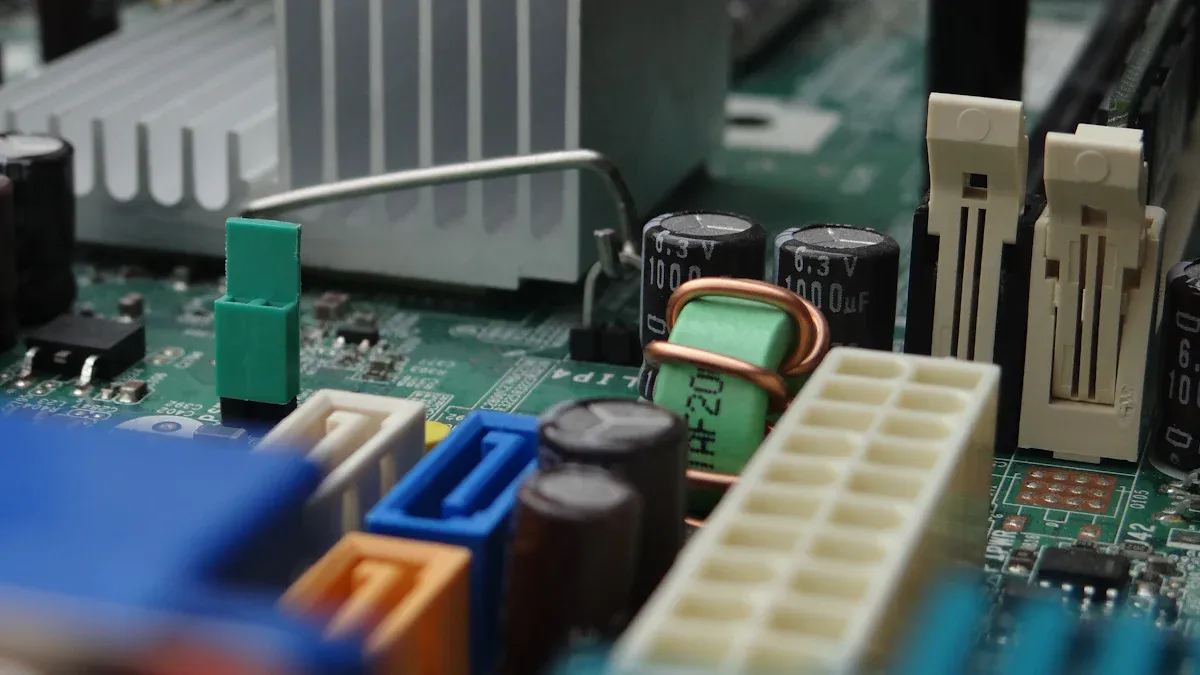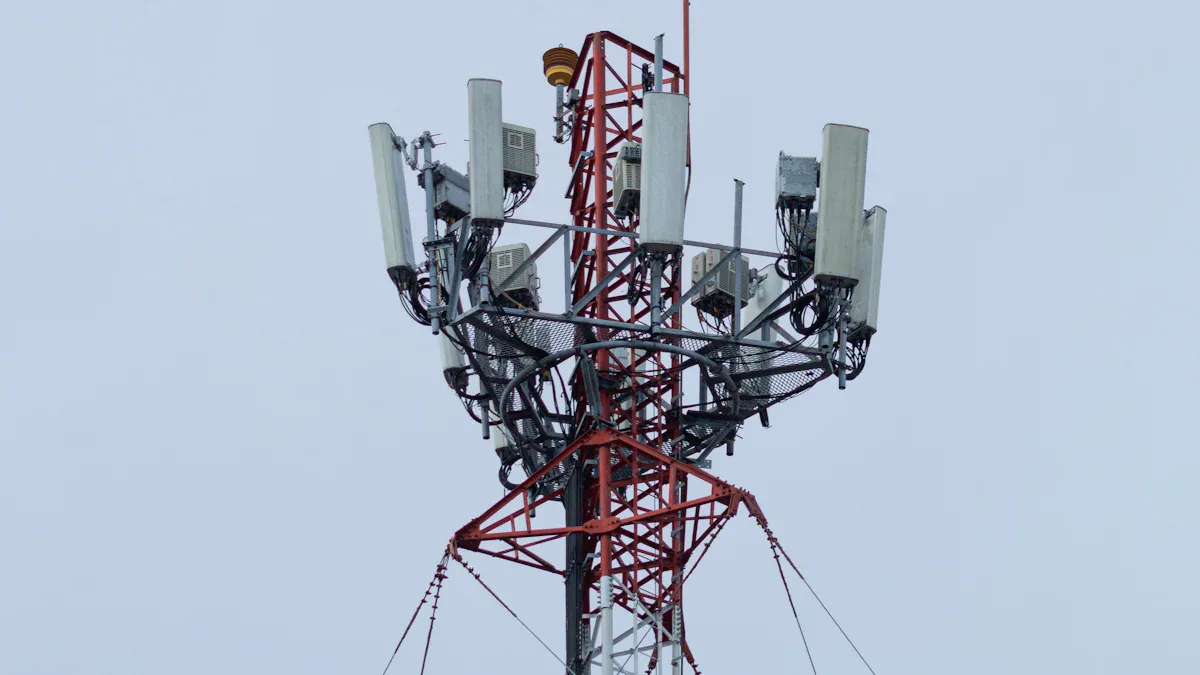A Beginner's Guide to ESTEL Telecom Rectifier Modules and Power Conversion

Telecom rectifier modules play a critical role in powering modern telecommunications systems. These devices convert alternating current (AC) from the electrical grid into direct current (DC) required by telecom equipment. By ensuring a consistent and efficient power supply, they help maintain uninterrupted communication services.
Modern telecom rectifiers, like ESTEL's 2025 models, achieve efficiency levels of up to 97%, significantly reducing energy loss during the conversion process.
ESTEL stands out in the industry with its advanced rectifier technology. Their solutions not only meet rigorous industry standards like NEBS Level 3 but also deliver up to 97.8% efficiency. This reduces energy consumption, enhances reliability, and supports sustainable operations.
Key Takeaways
Telecom rectifiers change AC power into DC power for telecom tools.
New rectifiers work up to 97% efficiently, saving energy and money.
Special materials like silicon carbide improve performance and cut energy waste.
These rectifiers work with backups to keep power on during outages.
Smart tools let users check them remotely and fix issues early.
How Telecom Rectifier Modules Work

Principles of AC to DC Conversion
Telecom rectifier modules are designed to convert alternating current (AC) into direct current (DC), a process essential for powering telecommunications equipment. AC power alternates its direction periodically, making it unsuitable for devices that require a steady flow of electricity. The rectification process ensures that the fluctuating AC is transformed into a stable DC output.
This conversion relies on diodes, which act as one-way gates for electrical current. Diodes allow current to flow in only one direction, effectively blocking the negative portion of the AC waveform. Modern telecom rectifier modules use advanced configurations, such as half-wave and full-wave rectification, to enhance the smoothness and efficiency of the DC output. These systems can achieve efficiency levels of up to 97.83%, making them ideal for applications like 5G networks and renewable energy projects.
Key Components of Telecom Rectifier Modules
Telecom rectifier modules consist of several critical components that work together to ensure efficient power conversion:
Input Filter: Removes noise from the power grid and prevents interference with other devices.
Rectification and Filtering: Converts AC power into a smoother DC output.
Inverter: Transforms rectified DC into high-frequency AC, optimizing the module's size and weight.
Output Rectification and Filtering: Delivers a stable DC supply to connected loads.
Control Methods: Includes techniques like Pulse Width Modulation (PWM) and Pulse Frequency Modulation (PFM) to regulate voltage and current.
Recent advancements in materials, such as silicon carbide (SiC) and gallium nitride (GaN), have further improved the performance of these components. These materials enable higher operational voltages and temperatures, reducing energy loss and enhancing overall efficiency.
The Rectification Process Explained
The rectification process begins with the input filter, which cleans the incoming AC power by removing noise and disturbances. The filtered AC then passes through a rectifier circuit, where diodes convert it into pulsating DC. Depending on the configuration, the rectifier may use a single diode (half-wave rectification) or multiple diodes arranged in a bridge (full-wave rectification).
After rectification, the DC output undergoes filtering to smooth out any remaining fluctuations. This step ensures a consistent voltage level, which is crucial for sensitive telecom equipment. Advanced telecom rectifier modules also include an inverter stage, which converts the rectified DC into high-frequency AC. This high-frequency AC is then rectified again to produce a highly stable and efficient DC output.
Metric | Description | Benefit to Telecom Systems |
|---|---|---|
Efficiency | Delta rectifiers outperform conventional models. | Reduces energy costs and improves reliability. |
Reliability | Operates across a broad voltage range. | Ensures continuous operation of telecom systems. |
Scalability | Modular design allows easy power capacity scaling. | Adapts to changing power demands seamlessly. |
By combining these steps, telecom rectifier modules provide a reliable and efficient power supply, ensuring uninterrupted operation of telecommunications infrastructure.
Role of Telecom Rectifier Modules in Power Conversion
Importance of Reliable Power Conversion
Reliable power conversion is essential for maintaining the performance and stability of telecommunications systems. You rely on telecom rectifier modules to ensure that your equipment receives a steady and uninterrupted power supply. These modules convert AC power into DC power, which is critical for the operation of telecom infrastructure.
When power conversion is unreliable, it can lead to voltage fluctuations, equipment failures, and service interruptions. Studies have shown that implementing advanced power conversion systems, such as those using proton exchange membrane fuel cells (PEMFCs), can significantly improve reliability.
Evidence Description | Findings |
|---|---|
Use of PEMFCs in telecom towers | Demonstrated reduced operational costs and improved reliability in power supply. |
Simulation results | Showed effectiveness in managing voltage and ensuring dependable power supply. |
Comparative analysis | Highlighted the superiority of the proposed system over existing methods in terms of efficiency and cost-effectiveness. |
By ensuring reliable power conversion, telecom rectifier modules help you avoid costly downtime and maintain seamless communication services.
Efficiency of High-Frequency Switching Power Supplies
High-frequency switching power supplies are a cornerstone of modern telecom rectifier modules. These systems operate at higher frequencies, allowing for smaller and more efficient components. You benefit from reduced energy loss and lower heat generation, which are critical for telecom systems that demand consistent performance.
Advancements in semiconductor materials, such as silicon carbide (SiC) and gallium nitride (GaN), have revolutionized these power supplies. These materials enable operation at higher frequencies while minimizing heat dissipation. This means your telecom systems can handle higher power loads without compromising efficiency.
For example, modern high-frequency switching power supplies achieve efficiency levels of up to 97%. This level of performance not only reduces energy costs but also supports the sustainability goals of telecom operators.
Benefits for Telecommunications Systems
Telecom rectifier modules offer numerous benefits that directly impact the efficiency and reliability of telecommunications systems. These modules ensure a stable power supply, even during power outages, by integrating seamlessly with backup systems like batteries and generators.
Globally, over 2.4 million telecom rectifier modules are installed, supporting approximately 500,000 telecom systems. These modules achieve an average efficiency of 97%, with future designs aiming for 98%. Their modular design allows you to scale power capacity as needed, making them ideal for both urban and remote areas.
Feature/Statistic | Value/Description |
|---|---|
Number of telecom rectifier systems | Approximately 500,000 used worldwide |
Number of rectifier modules | Over 2.4 million installed globally |
Efficiency of rectifier modules | About 97%, with future designs aiming for 98% |
Market share of DC power systems | 63% in remote areas |
Role during power outages | Key in backup systems like batteries and generators |
Additionally, smart monitoring features in modern rectifiers reduce downtime by 25% and can lower annual energy costs by up to 5%. These benefits make telecom rectifier modules indispensable for maintaining the reliability and efficiency of your telecommunications infrastructure.
Types of Telecom Rectifier Modules
Telecom rectifier modules come in various configurations, each designed to meet specific power conversion needs. Understanding the differences between these types helps you choose the right solution for your telecommunications systems.
Half-Wave Rectifiers
Half-wave rectifiers are the simplest type of rectifier. They use a single diode to convert alternating current (AC) into direct current (DC). The diode allows only one half of the AC waveform to pass through, blocking the other half. This results in a pulsating DC output.
You might find half-wave rectifiers in low-power applications due to their simplicity and cost-effectiveness. However, they are less efficient compared to other rectifier types. The output contains significant ripple, which may require additional filtering for sensitive telecom equipment.
Tip: Half-wave rectifiers are ideal for basic, low-demand systems where cost is a primary concern.
Full-Wave Rectifiers
Full-wave rectifiers improve upon the half-wave design by utilizing both halves of the AC waveform. They typically use two diodes and a center-tapped transformer. This configuration doubles the efficiency of power conversion and produces a smoother DC output.
These rectifiers are well-suited for medium-power applications. You can rely on them for systems that require a more stable power supply. The reduced ripple in the output minimizes the need for extensive filtering, making them a popular choice in telecom rectifier modules.
Feature | Half-Wave Rectifier | Full-Wave Rectifier |
|---|---|---|
Diodes Required | 1 | 2 |
Efficiency | Lower | Higher |
Output Ripple | High | Low |
Bridge Rectifiers and Their Use Cases
Bridge rectifiers take efficiency and performance to the next level. They use four diodes arranged in a bridge configuration. This design eliminates the need for a center-tapped transformer and allows the rectifier to utilize both halves of the AC waveform.
You can use bridge rectifiers in high-power applications where efficiency and reliability are critical. They are common in modern telecom systems, renewable energy setups, and industrial power systems. Their compact design and high efficiency make them a versatile choice for various scenarios.
Note: Bridge rectifiers are the most efficient option for telecom rectifier modules, offering superior performance and reliability.
Applications of Telecom Rectifier Modules

Telecommunications Infrastructure
Telecom rectifier modules are the backbone of modern telecommunications infrastructure. They ensure a stable and efficient power supply for critical equipment like base stations, data centers, and network hubs. You rely on these modules to maintain uninterrupted communication services, even during power outages.
Their modular design allows you to scale power capacity as your network grows. For example, in remote areas, these modules integrate seamlessly with backup systems like batteries and generators. This ensures that your telecom systems remain operational under challenging conditions. Additionally, advanced monitoring features in modern rectifiers provide real-time alerts, reducing downtime and improving overall system reliability.
Renewable Energy Systems
Telecom rectifier modules also play a vital role in renewable energy systems. They convert the variable AC output from renewable sources like solar panels and wind turbines into a stable DC supply. This makes them essential for hybrid power setups that combine renewable energy with traditional grid power.
You benefit from their high efficiency, which minimizes energy losses and maximizes the use of renewable resources. For instance, ESTEL's Delta rectifier models consistently achieve efficiency ratings above 95%. This reduces operational costs and supports sustainability goals. Their durable construction ensures reliable performance, even in harsh environmental conditions, making them ideal for off-grid renewable energy installations.
Industrial Power Systems
In industrial settings, telecom rectifier modules provide reliable power conversion for equipment that demands consistent performance. These modules excel in maintaining stable power output, even under fluctuating load conditions.
Model Type | Maintenance Frequency | Special Features |
|---|---|---|
Low-Capacity (<10kW) | Low | Compact design, minimal wear components |
Medium-Capacity (10-50kW) | Moderate | Modular structure, advanced diagnostics |
High-Capacity (>50kW) | Moderate to High | Enhanced cooling, fault-tolerant systems |
You can rely on their modular design for easy component replacement, reducing downtime. Self-diagnostic systems provide real-time alerts, helping you address potential issues before they escalate. These features make telecom rectifier modules indispensable for industrial applications requiring high reliability and efficiency.
Advancements in Telecom Rectifier Module Technology
Trends in Energy Efficiency
Energy efficiency has become a key focus in telecom rectifier module technology. You benefit from advancements in wide-bandgap (WBG) semiconductors like silicon carbide (SiC) and gallium nitride (GaN). These materials improve power conversion efficiency and reduce energy losses. Modern rectifiers now operate at higher voltages and temperatures, making them more versatile for various applications.
The table below highlights the improvements in energy efficiency:
Parameter | Improvement Description |
|---|---|
Efficiency | Enhanced efficiency in power devices due to better material properties of WBG semiconductors. |
Power Density | Increased power density allows for more compact designs. |
Heat Dissipation | Improved thermal management capabilities, leading to better performance under load. |
Operational Capabilities | Ability to operate at higher voltages and temperatures, expanding application range. |
Switching Speed | Propagation delays reduced to 5 ns, enabling MHz operation in traditional designs. |
System Size and Weight | Overall reductions in system size and weight due to integration of components. |
These advancements not only lower energy costs but also support sustainability goals by reducing carbon footprints.
Miniaturization and Compact Designs
The demand for smaller, more efficient telecom rectifier modules has grown significantly. You see this trend driven by the rise of consumer electronics, IoT devices, and wearable technology. Manufacturers now use GaN-based rectifiers to create ultra-slim designs that align with modern device aesthetics.
Evidence Description | Key Data Points |
|---|---|
Demand for compact power supplies | Proliferation of consumer electronics and IoT devices |
Global shipments of wearables and smart home devices | Exceeded 1.8 billion units in 2023 |
Adoption of GaN-based rectifiers | Enabled smaller form factors, aligning with ultra-slim designs of major brands like Apple and Samsung |
Miniaturization also improves portability and reduces installation costs, making these modules ideal for both urban and remote telecom systems.
Integration with Smart Systems
Modern telecom rectifier modules now integrate seamlessly with smart systems. You can monitor and control these modules remotely, thanks to advanced IoT-enabled features. Predictive maintenance tools identify potential failures before they occur, reducing downtime and improving reliability.
Statistic Description | Impact |
|---|---|
Cost Savings | Predictive maintenance saves approximately 8% to 12% over preventive maintenance and up to 40% over reactive maintenance. |
Equipment Reliability | It improves equipment reliability by addressing potential failures before they occur. |
Downtime Reduction | Predictive maintenance helps prevent disruptions and minimizes downtime by identifying potential failures in advance. |
These smart features ensure your telecom systems remain operational while lowering maintenance costs and enhancing overall efficiency.
Telecom rectifier modules are essential for ensuring reliable and efficient power conversion in modern systems. They provide the stable DC power that your telecommunications infrastructure depends on. Without them, maintaining uninterrupted communication would be nearly impossible.
ESTEL leads the industry with cutting-edge rectifier technology. Their solutions deliver unmatched efficiency, scalability, and reliability, making them a trusted choice for telecom operators worldwide.
Explore ESTEL's product offerings today. You’ll find innovative designs tailored to meet your power conversion needs while supporting sustainable operations.
FAQ
What is the main purpose of a telecom rectifier module?
Telecom rectifier modules convert AC power from the grid into DC power required by telecom equipment. They ensure a stable and reliable power supply, which is essential for uninterrupted communication services.
How do telecom rectifier modules improve energy efficiency?
Modern modules use advanced materials like silicon carbide (SiC) and gallium nitride (GaN). These materials reduce energy loss during conversion and enable high-frequency operation, achieving efficiency levels of up to 97%.
Can telecom rectifier modules handle power outages?
Yes, they integrate with backup systems like batteries and generators. This ensures your telecom infrastructure remains operational during outages, maintaining seamless communication.
What types of rectifiers are commonly used in telecom systems?
You’ll find half-wave, full-wave, and bridge rectifiers. Bridge rectifiers are the most efficient and reliable, making them ideal for high-power applications in telecom systems.
Are telecom rectifier modules suitable for renewable energy systems?
Absolutely! They convert variable AC output from renewable sources like solar panels into stable DC power. This makes them essential for hybrid setups combining renewable energy with traditional grid power.
See Also
Essential Insights for Newcomers on Telecom Power Systems
Understanding the ESTEL Power System for Telecom Cabinets
Calculating Power Systems and Battery Needs for Telecom Cabinets
Exploring Energy Storage Solutions for ESTEL Telecom Cabinets
Ensuring Optimal Voltage Levels in ESTEL Communication Cabinets
CALL US DIRECTLY
86-13752765943
3A-8, SHUIWAN 1979 SQUARE (PHASE II), NO.111, TAIZI ROAD,SHUIWAN COMMUNITY, ZHAOSHANG STREET, NANSHAN DISTRICT, SHENZHEN, GUANGDONG, CHINA


